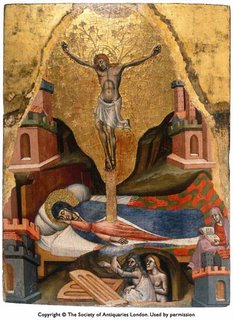
Just back from a couple of days in London at the British Library, a bit of book shopping, and a trip to the National Gallery. The shopping was good: I picked up Skeat's own copy of Furnivall's edition of Harl. 7334 published for the Chaucer Society in 1885. Very pleased, and for a fiver; a bargain I rather think. I was very pleased to go to see one the National Gallery's newest pieces, on loan from the Soc. of Antiquaries. It is a small panel painting entitled 'Dream of the Virgin' by a Bolognese artist called Simone dei Crocefissi (c.1330-1399). He is famous for four large crucifixes in Bologna (at the Palazzo Comunale, S. Giacomo Maggiore, at the Museo S. Stefano, and at S. Giuseppe) which gave him his nickname. He worked mainly in Bologna and became one of the city's most prolific artists during the period.
This painting, dating c.1370-80, shows Simone's use of striking and unusual devotional imagery. The Virgin is shown asleep, being read to by a female companion seated at the end of the bed. Out of the Virgin's side springs a piece of wood upon which hangs Jesus, although a cross is not actually represented. The usual interpretation is that it represents the lignum vitae, the Tree of Life. The composition might be divided between the upper section and lower section divided by the horizontally-placed Virgin. Thus she is the connection between Christ's death on the cross and Man's redemption. The blood of Christ is often represented in altar-pieces as flowing out of his side (sometimes being collected in cups by angels), but this is nicely mirrored by the Virgin having her own side wound out of which comes the suffering of her son on the cross. Christ's redemption is depicted by a hand that protrudes from the dream space to help Adam and Eve out of Hell. She sleeps with her head resting on one hand and her other arm by her side. The pose is very natural and rather delicately done. She is sleeping on a colourful duvet cover that looks very modern, really. Notice how the whole scene is framed with architectural imagery, towers and roofs that are all very reminiscent of Bologna itself. The piece is not of the very highest quality, and this is only too evident when you turn right around and look at the Wilton Diptych behind you. This beautiful gem never fails to impress me, no matter how many times I see it. But if Simone's work is not of the highest artistic quality it is at least unorthodox in a way the Wilton Diptych certainly is not, and surely betrays an intellectually lively audience striving for devotional expression.
For those who wish to read more I recommend Robert Gibbs, Grove Dictionary of Art, s.v.; ibid, 'Two Families of Painters at Bologna in the Later Fourteenth Century', Burlington Mag. CXXI (1979), 560-68; ibid., 'Bolognese Trecento Painting', Burl. Mag. CXX (1978), 237-8; Victoria Markova, 'The Annunciation from the Collection of Moscow's Pushkin Museum and Certain Aspects of Simone dei Crocefissi's Later Works', Burl. Mag. CXX (1978), 4-6. See also Massimo Ferretti, Rappresentazione dei Magi: il gruppo ligneo di S. Stefano e Simone dei Crocefissi (Bologna: ALFA, 1981)[Exh. Cat.].
This painting, dating c.1370-80, shows Simone's use of striking and unusual devotional imagery. The Virgin is shown asleep, being read to by a female companion seated at the end of the bed. Out of the Virgin's side springs a piece of wood upon which hangs Jesus, although a cross is not actually represented. The usual interpretation is that it represents the lignum vitae, the Tree of Life. The composition might be divided between the upper section and lower section divided by the horizontally-placed Virgin. Thus she is the connection between Christ's death on the cross and Man's redemption. The blood of Christ is often represented in altar-pieces as flowing out of his side (sometimes being collected in cups by angels), but this is nicely mirrored by the Virgin having her own side wound out of which comes the suffering of her son on the cross. Christ's redemption is depicted by a hand that protrudes from the dream space to help Adam and Eve out of Hell. She sleeps with her head resting on one hand and her other arm by her side. The pose is very natural and rather delicately done. She is sleeping on a colourful duvet cover that looks very modern, really. Notice how the whole scene is framed with architectural imagery, towers and roofs that are all very reminiscent of Bologna itself. The piece is not of the very highest quality, and this is only too evident when you turn right around and look at the Wilton Diptych behind you. This beautiful gem never fails to impress me, no matter how many times I see it. But if Simone's work is not of the highest artistic quality it is at least unorthodox in a way the Wilton Diptych certainly is not, and surely betrays an intellectually lively audience striving for devotional expression.
For those who wish to read more I recommend Robert Gibbs, Grove Dictionary of Art, s.v.; ibid, 'Two Families of Painters at Bologna in the Later Fourteenth Century', Burlington Mag. CXXI (1979), 560-68; ibid., 'Bolognese Trecento Painting', Burl. Mag. CXX (1978), 237-8; Victoria Markova, 'The Annunciation from the Collection of Moscow's Pushkin Museum and Certain Aspects of Simone dei Crocefissi's Later Works', Burl. Mag. CXX (1978), 4-6. See also Massimo Ferretti, Rappresentazione dei Magi: il gruppo ligneo di S. Stefano e Simone dei Crocefissi (Bologna: ALFA, 1981)[Exh. Cat.].
No comments:
Post a Comment